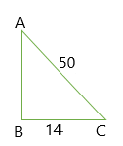
a.
To calculate thearea of right
a.
Answer to Problem 24PSB
The area of right-angle triangle
Explanation of Solution
Given:
Formula Used:
The below theorem is used:
Pythagoras theorem states that “In a right angled triangle, the square of the hypotenuse side is equal to the sum of squares of the other two sides”.
Calculation:

In right angled
b.
To find the altitude BD to hypotenuse side AC.
b.
Answer to Problem 24PSB
The altitude BD is
Explanation of Solution
Given:
Formula Used:
Calculation:

Chapter 11 Solutions
Geometry For Enjoyment And Challenge
Additional Math Textbook Solutions
Probability and Statistics for Engineers and Scientists
Introductory and Intermediate Algebra for College Students (5th Edition)
Precalculus Enhanced with Graphing Utilities (7th Edition)
Finite Mathematics for Business, Economics, Life Sciences and Social Sciences
Mathematics with Applications In the Management, Natural, and Social Sciences (12th Edition)
A Problem Solving Approach To Mathematics For Elementary School Teachers (13th Edition)
 Elementary Geometry For College Students, 7eGeometryISBN:9781337614085Author:Alexander, Daniel C.; Koeberlein, Geralyn M.Publisher:Cengage,
Elementary Geometry For College Students, 7eGeometryISBN:9781337614085Author:Alexander, Daniel C.; Koeberlein, Geralyn M.Publisher:Cengage, Elementary Geometry for College StudentsGeometryISBN:9781285195698Author:Daniel C. Alexander, Geralyn M. KoeberleinPublisher:Cengage Learning
Elementary Geometry for College StudentsGeometryISBN:9781285195698Author:Daniel C. Alexander, Geralyn M. KoeberleinPublisher:Cengage Learning

